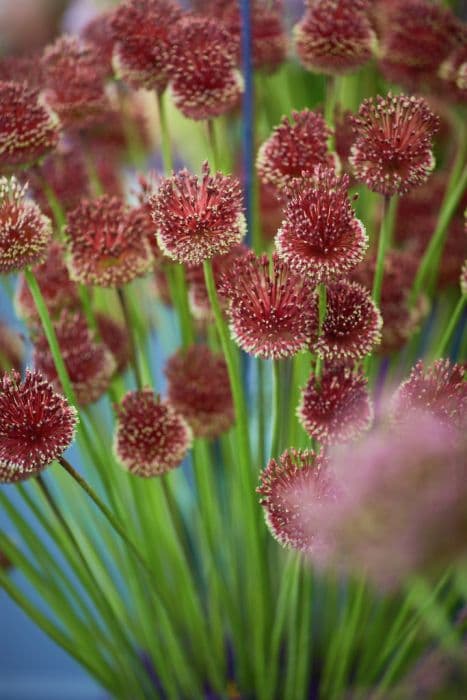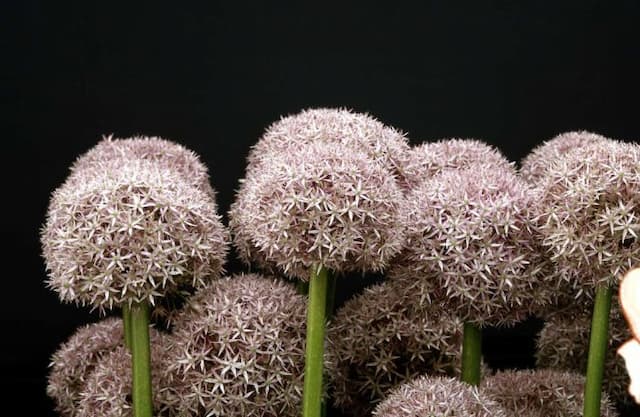Rosen’s onion Allium rosenorum 'Michael H. Hoog'

ABOUT
The Allium rosenorum 'Michael H. Hoog', commonly known as an ornamental onion, is characterized by its attractive and distinctive spherical flowers. The blooms are made up of numerous small, star-shaped flowers tightly packed together to form a rounded cluster, often likened to a floral pom-pom. These flower clusters are perched atop sturdy stems and present a striking visual against the plant's green foliage. The leaves of the ornamental onion are typically strap-shaped, lush, and create a verdant background that contrasts the vibrant blooms above. The color of the flowers can vary but often includes shades of purple, pink, or white, which can add a pop of color to garden landscapes. The plant has an architectural quality due to the prominence of its flower spheres, making it a standout feature in any garden setting. This Allium species, like its relatives, is enjoyed for its ornamental appeal but also serves the practical purpose of deterring many types of garden pests due to its distinctive onion-like scent. The foliage generally has a glossy appearance and may remain attractive even after the blooms have faded, adding prolonged interest to the plant's display in the garden.
About this plant
 Names
NamesFamily
Amaryllidaceae.
Synonyms
Rosen's Onion, Michael H. Hoog Allium.
Common names
Allium rosenorum 'Michael H. Hoog'.
 Toxicity
ToxicityTo humans
Allium rosenorum 'Michael H. Hoog', commonly known as wild onion, is not considered highly toxic to humans. However, consuming large amounts of this plant may cause gastrointestinal irritation, including symptoms like nausea, vomiting, and diarrhea, due to the various sulfur compounds it contains. It is generally not life-threatening, but some individuals may have sensitivities or allergies to members of the Allium family, which could lead to more pronounced reactions.
To pets
Wild onion, the common name for Allium rosenorum 'Michael H. Hoog', is toxic to cats and dogs. Ingesting this plant can lead to symptoms like nausea, vomiting, abdominal pain, and diarrhea in pets. More severe cases of poisoning could result in red blood cell damage leading to hemolytic anemia, which is characterized by symptoms such as lethargy, weakness, red urine, jaundice, and increased heart rate. Immediate veterinary attention is recommended if a pet consumes wild onion.
 Characteristics
CharacteristicsLife cycle
Perennials
Foliage type
Deciduous
Color of leaves
Green
Flower color
Purple
Height
2 feet [60 cm]
Spread
1 foot [30 cm]
Plant type
Bulb
Hardiness zones
4
Native area
Caucasus
Benefits
 General Benefits
General Benefits- Enhances Biodiversity: Attracts beneficial pollinators like bees and butterflies, contributing to a healthy ecosystem.
- Aesthetic Appeal: Adds visual interest to gardens with its colorful blooms and unique structure.
- Culinary Uses: Provides flavorful additions to a variety of dishes, as some alliums are edible.
- Low Maintenance: Typically requires minimal care once established, making it suitable for many gardeners.
- Drought Resistant: Can thrive in dry conditions once mature, conserving water resources.
- Pest Deterrence: Often repels many common garden pests, reducing the need for chemical repellents.
- Adaptable Growth: Capable of growing in a range of environments, from full sun to part shade.
 Medical Properties
Medical PropertiesThis plant is not used for medical purposes.
 Air-purifying Qualities
Air-purifying QualitiesThis plant is not specifically known for air purifying qualities.
 Other Uses
Other Uses- Biodegradable pesticide: The essential oils derived from the plant can be used as natural pesticides, deterring pests without the use of harsh chemicals.
- Flavoring agent: Due to its unique aromatic properties, it can be used to impart a distinctive flavor in gourmet cooking.
- Crafts and decorations: Dried flowers of Allium rosenorum can be used to create beautiful and long-lasting floral arrangements.
- Natural dye: The plant can be processed to extract natural dyes for textiles, providing a spectrum of colors depending on the mordant used.
- Photography subject: It's an interesting subject for botanical photographers due to its aesthetic flower structure.
- Culinary garnish: Fresh flowers can be used to add a touch of elegance and flavor as garnishes on sophisticated dishes.
- Educational use: It can be used in botanical studies to teach about plant biology, specifically in relation to the Alliaceae family.
- Erosion control: Its root system can help stabilize the soil and manage erosion in certain landscapes.
- Companion planting: This plant may be utilized in companion planting to help protect neighboring plants by repelling certain insects and pests.
- Garden design element: With its distinctive appearance, it adds variety and visual interest to garden designs and landscapes.
Interesting Facts
 Feng Shui
Feng ShuiThe Allium is not used in Feng Shui practice.
 Zodiac Sign Compitability
Zodiac Sign CompitabilityThe Allium is not used in astrology practice.
 Plant Symbolism
Plant Symbolism- Persistence and strength: Being a member of the Allium family, which includes onions and garlic, the Allium rosenorum 'Michael H. Hoog' symbolizes durability and the ability to withstand adversity, as these plants are known for their hearty nature and ability to grow in tough conditions.
- Unity: The spherical shape of the Allium flower is often interpreted as a symbol of unity and togetherness, as it is made up of many small, closely packed florets.
- Good fortune: In some cultures, Alliums are thought to bring luck and are planted to ward off evil spirits, possibly because of their strong scent and potentially protective properties.
- Humility: The Allium's simple beauty and the way its flower head bows down as it matures can represent humility and modesty.
- Patience: Since Alliums can take a while to bloom and require little upkeep, they can signify patience and the reward of waiting.
 Water
WaterOrnamental onion plants, including Allium rosenorum 'Michael H. Hoog', prefer moderately moist soil, so it's recommended to water them weekly with about 1 inch of water. Adjust this schedule during periods of rain or drought, aiming to keep the soil consistently moist but not waterlogged. Use a soaker hose or drip irrigation to deliver water directly to the roots, minimizing moisture on the foliage which can lead to fungal diseases. During the growing season, if there hasn't been significant rainfall, provide up to 2 gallons of water per square foot per month to maintain adequate soil moisture.
 Light
LightOrnamental onions thrive in full sun conditions, so place Allium rosenorum 'Michael H. Hoog' in a location where it can receive at least six hours of direct sunlight daily. These plants do well in bright, unfiltered sunlight for most of the day, so a south-facing spot would be ideal. Avoid areas with too much shade, as this can inhibit flower blooming and weaken the plant.
 Temperature
TemperatureOrnamental onions, like Allium rosenorum 'Michael H. Hoog', typically grow best in temperatures between 55°F and 75°F. They are hardy and can survive in temperatures as low as 28°F and as high as 90°F, but extreme temperatures may cause stress. To promote healthy growth, plant them in an area where they'll experience temperature fluctuations within their ideal range throughout the day.
 Pruning
PruningPrune ornamental onion plants like Allium rosenorum 'Michael H. Hoog' to remove spent flowers and encourage reblooming. Deadheading after flowering can prevent self-seeding if desired. Cut back foliage only after it has completely died back, typically in late summer or early fall. This helps the plant direct energy back to the bulb for the next growing season. Annual pruning to clean up old leaves and faded blooms is all that is generally required.
 Cleaning
CleaningAs needed
 Soil
SoilOrnamental onion 'Michael H. Hoog' prefers a well-draining soil rich in organic matter with a pH ranging from 6.0 to 7.5. A good soil mix for this plant would consist of one part garden soil, one part compost or well-rotted manure, and one part sand or perlite to ensure proper drainage.
 Repotting
RepottingOrnamental onions like 'Michael H. Hoog' typically do not need frequent repotting and can be done every 3 to 4 years or when the bulbs multiply and begin crowding. The best time to repot is after the foliage has died back.
 Humidity & Misting
Humidity & MistingOrnamental onion 'Michael H. Hoog' is tolerant of a wide range of humidity levels as long as it's growing in well-draining soil. Average room humidity is usually sufficient for this plant.
 Suitable locations
Suitable locationsIndoor
Place in well-lit area, avoid overwatering, use well-draining soil.
Outdoor
Full sun, well-draining soil, water moderately.
Hardiness zone
4-8 USDA
 Life cycle
Life cycleAllium rosenorum 'Michael H. Hoog', also known as Rosen's onion, begins its life as a dormant bulb, which upon receiving adequate sunlight, moisture, and warmth, will sprout and grow roots. In the growth stage, foliage emerges, usually consisting of strappy green leaves, and the plant undergoes vegetative growth. Following the vegetative phase, it enters the reproductive stage, where it develops a tall stem topped with a characteristic spherical bloom made up of many small flowers. After pollination, typically by insects or wind, the flowers set seed, and the plant begins to senesce, with the foliage dying back as the plant's energy is redirected into seed and bulb development. The seeds mature and are dispersed in the environment, potentially leading to the growth of new plants, while the original bulb enters a period of dormancy. During this dormancy, the bulb conserves energy and awaits the appropriate season to begin the life cycle anew.
 Propogation
PropogationPropogation time
Spring-Early Summer
Allium rosenorum 'Michael H. Hoog', more commonly known as ornamental onion, is typically propagated by dividing its bulbs. The ideal time for dividing and replanting bulbs is after the foliage has died back, which is usually in late summer or early fall. To propagate, gently dig up the clumps of bulbs and carefully separate them by hand, making sure each division has at least one growing point or shoot. Replant the bulbs at the same depth they were growing before, which is about three times the height of the bulb, and space them approximately 6 to 8 inches apart (15-20 cm). Water the newly planted bulbs thoroughly to help establish them. This method harnesses the plant's natural reproductive cycle and results in an exact clone of the parent plant.









